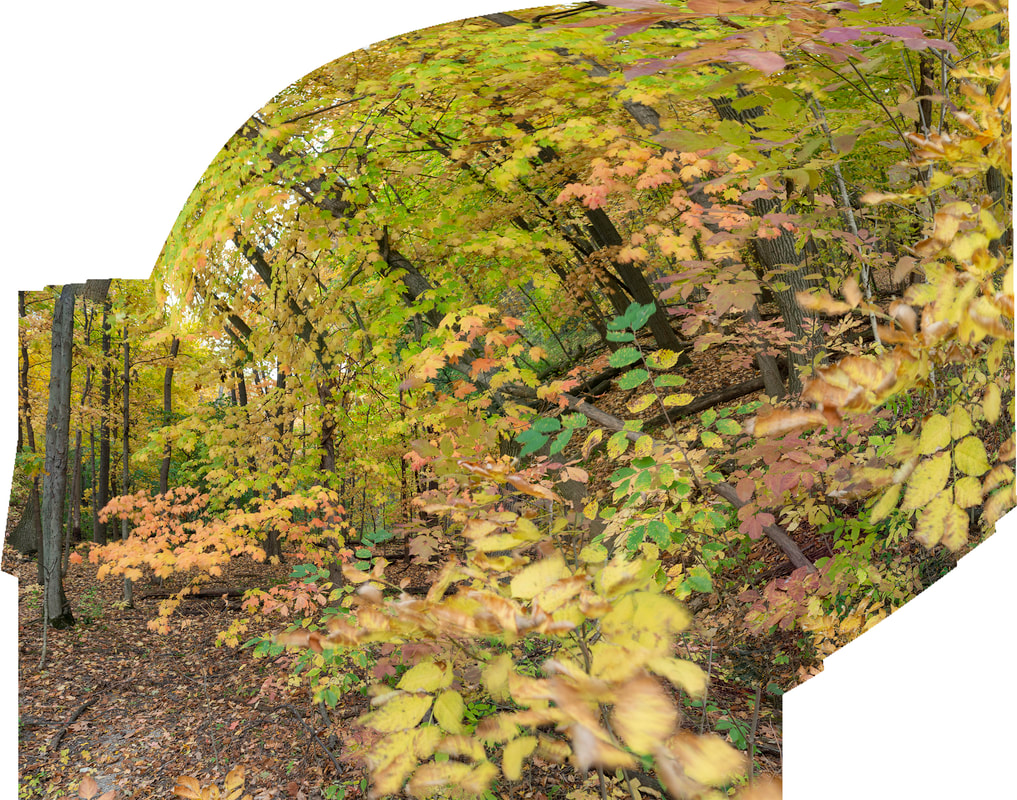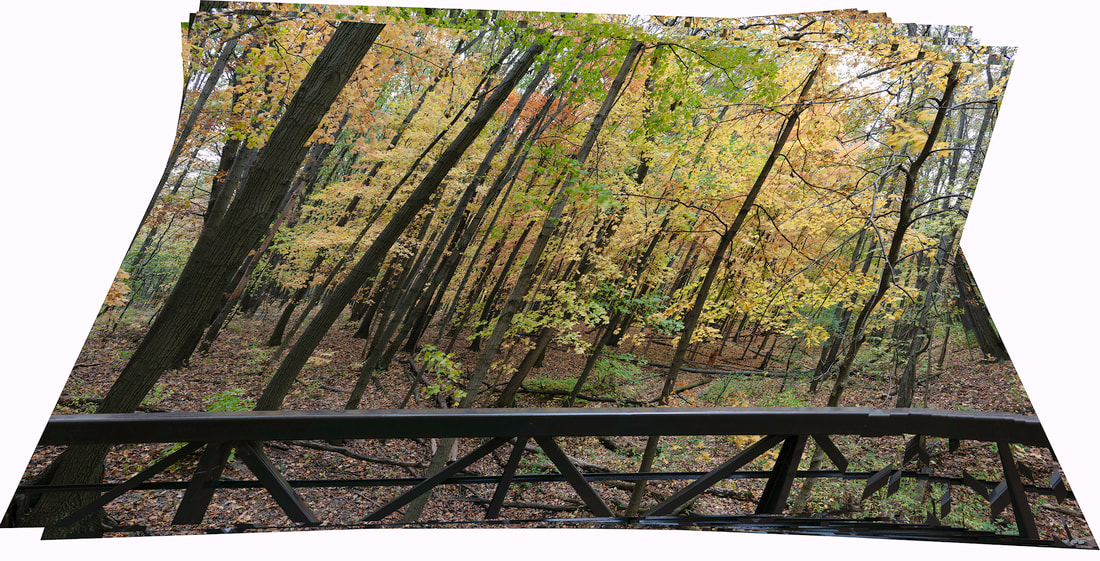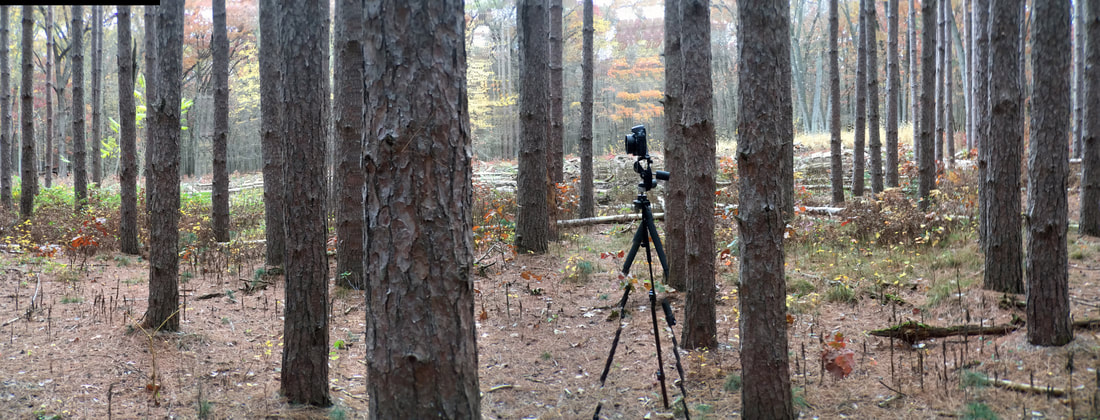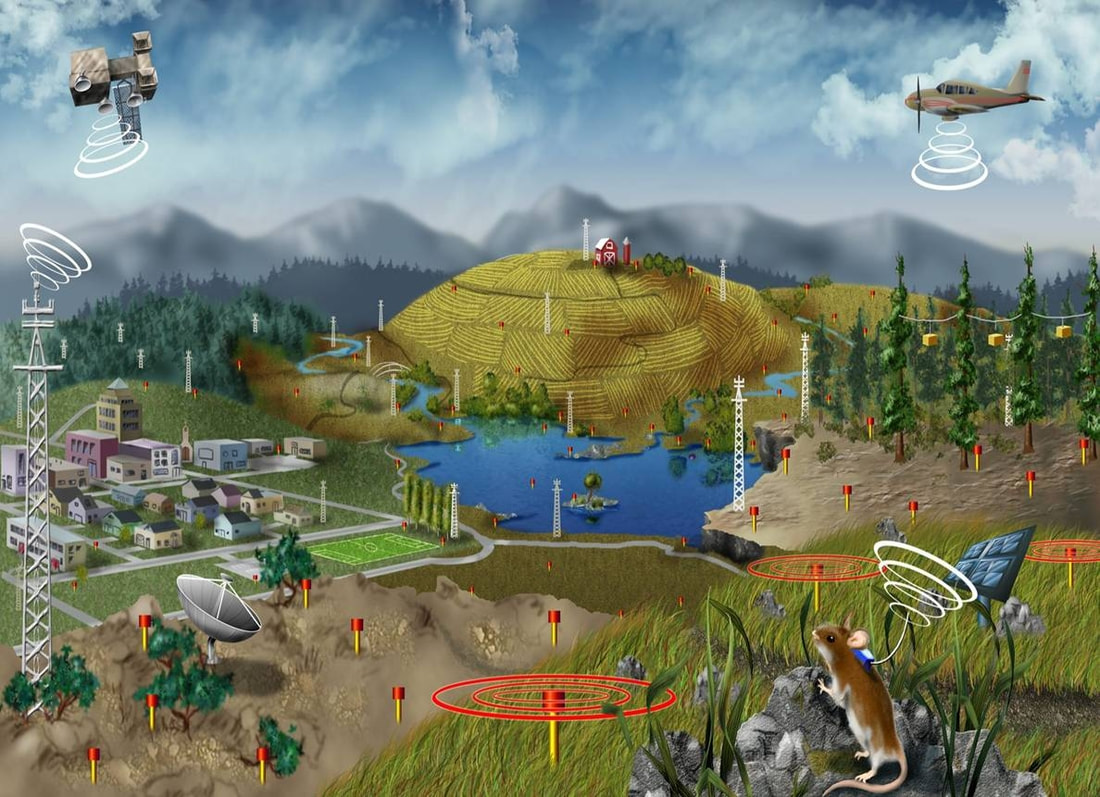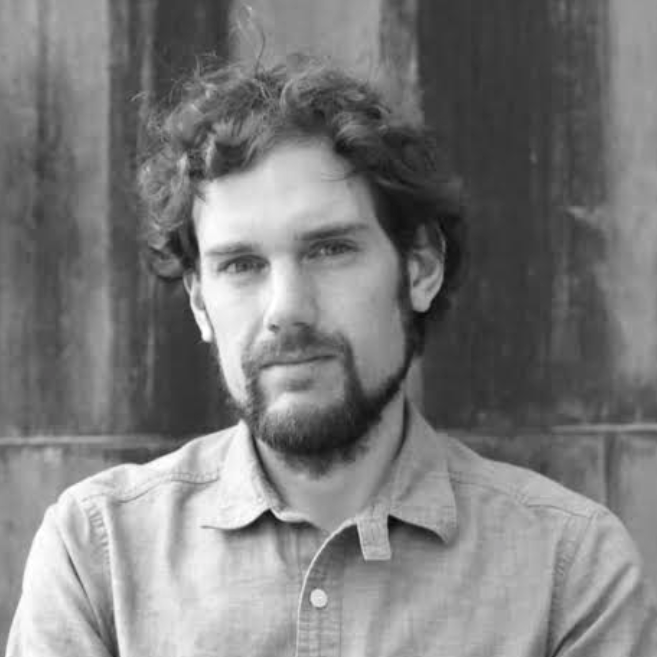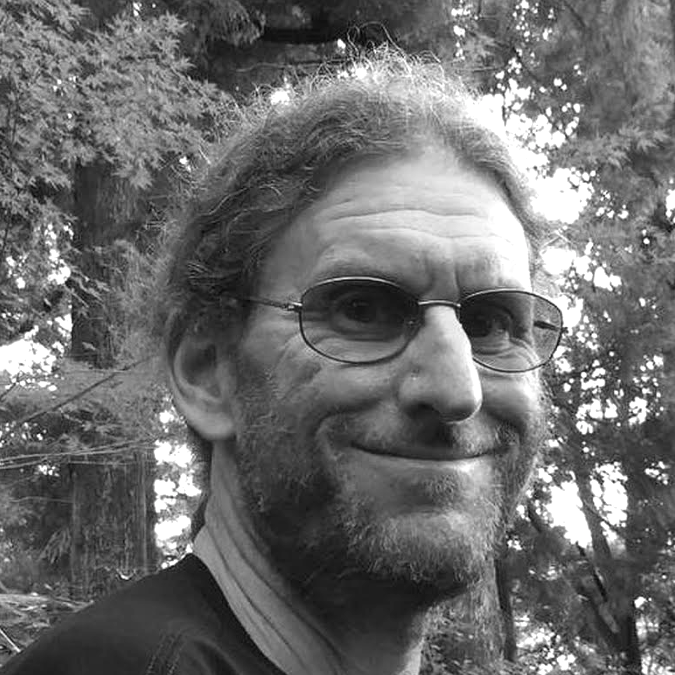|
Eric The last two weeks have been spent continuing the attempts to find the limits, or flaws, of the imaging software I’ve been using, and to understand better the act of looking at a forest, or an ecosystem. First, I’ll bring us up to date on the images. I made photographs in two different locations this time, the first at the Fallen Timbers Battlefield Park, and the second at “The Spot” in Oak Openings Metropark. The Battlefield location was chosen out of convenience and interest; the maples were exceptionally bright in color that weekend, and “The Spot” is an example of a plantation forest, which Aaron and I had been chatting about in our weekly meetings. At the Battlefield, I attempted to be more systematic and precise while taking the initial images which were later fed to Photoshop. For the first image, I laid down a string to demarcate a linear viewing area, and then I moved the camera and tripod 9” to the right after each exposure. For the second test, I used a bridge in the park as a guide for the tripod legs, and moved to the right 8” at a time, including the bridge railing in the base of the images so Photoshop might have something linear to grab hold of while calculating a panorama. As you can see, neither test went according to plan. The first image (fig. 1) collapsed over itself, as the cacophony of leaves and branches melted into one another and became distorted. In the second (fig. 2), the bridge railing helped, but only served to make the image edges choppy instead of smooth for some reason. Of course, I expected the results to be unrealistic, given that the program was being fed information outside its intended inputs, but usually, that is the process I use to find out exactly what the limits for inputs to a program are. Strangely, when using an iPhone to create a panorama (an iPhone 6s in this case), I was able to walk in a straight line and gather an image that made some sense, as seen in the image from “The Spot” below (fig. 3). As I mentioned above, I went to “The Spot” because it is a remnant of a plantation forest, planted by the WPA in order to hold the sandy soil in place in the area and to provide a revenue stream for the parks. Aaron and I are interested in the plantation forests as examples of constructed environments, and we are curious about what the process of studying and imaging them may bring about. Due to its age, this particular forest has a short life span ahead of it, despite being a hugely popular local site for posed photographs. (Just search Instagram for “Oak Openings” and you will see what I mean.) It’s also worth noting that this tiny spot (fig 4.) more than likely has served more often as a backdrop for images, and is more widely known than the entire painstakingly restored and preserved park around it. To see what a “normal” panorama of the same view looks like, you can compare the image to fig. 4. Aaron A common question for scientists involved in art/science collaborations is whether art changes (or at least influences) science. This topic was explored in some depth two years ago in SciArt Magazine (October 2018). My own contribution, co-authored with my long-time collaborator David Buckley Borden, concluded that “major breakthroughs or innovations from art-science collaborations are more likely to be the exception than the rule”, but that as scientists working in collaboration with artists that we can expect to have our assumptions challenge, our work refracted through new creative lenses, and gain new sets of critical thinking skills that expand our scientific practice in unexpected ways. The value of the unexpected was brought home to me last week when I read Ruth Margalit’s review of several novels by Ronit Matalon that have recently been translated into English from their original Hebrew. Most chapters of Matalon’s novel The One Facing Us open with an old photograph of the narrator’s relatives. Margalit notes that the chapters then focus on minor, easily overlooked, or unintended details of the photographs. She then draws in Walter Benjamin’s observation in his 1931 essay “A Short History of Photography” that the viewer of a photograph (Benjamin’s “spectator”) : “feels an irresistible compulsion to look for the tiny spark of chance, of the here and now, with which reality has, as it were, seared the character in the picture; to find that imperceptible point at which, in the immediacy of that long-past moment, the future so persuasively inserts itself that, looking back, we may rediscover it.” (from the 1972 translation by Stanley Mitchell) The ”tiny sparks of chance” in photographs are analogous to the detailed, often serendipitous observations that send scientists and their research in unanticipated directions. The remarkable, often unexpected natural-history observations made from the late 18th through the 19th centuries were grist for theoretical mills that annealed ecology and evolutionary biology into a new science. Among many examples, Darwin and Wallace’s years of meticulous observations and experiments inspired and grounded the theory of evolution by natural selection, while von Humboldt’s explorations set the basis for our understanding of how distributions of plants and animals are governed by climate – theories that still guide our models and forecasts of the effects of ongoing global climatic change. Yet, the institutionalization of ecology in the late 19th and early 20th centuries was paralleled by a devaluing of natural history, which was left to “amateurs”, while professional ecologists focused on developing general theories often unconstrained by data. And just as ecologists could ask whether natural history was still science (a question still posed today), Benjamin highlighted tensions between art and photography: photography as art, art as photography, and photography of works of art. “A Short History of Photography” was written 90 years after the invention of the daguerreotype. Now, 90 years further on, Benjamin’s “tiny spark of chance” continues to sear photographs, but his subsequent lines highlight new intersections between art and science: “It is indeed a different nature that speaks to the camera from the one which addresses the eye; different above all in the sense that instead of a space worked through by a human consciousness there appears one which is affected unconsciously.” (from the 1972 translation by Stanley Mitchell) Just as photography and other creative arts are increasingly shaped and impacted by emerging technologies (discussed recently by Hans Ulrich Obrist), so ecology and our understanding and interpretation of nature increasingly is determined by webs of sensors, computers, data clouds and models that interpose themselves between our eyes and our brains. Interrogating Obrist, I pose the question: what is implied about us and our world in this scientiartistic co-production of reality?
0 Comments
Leave a Reply. |

